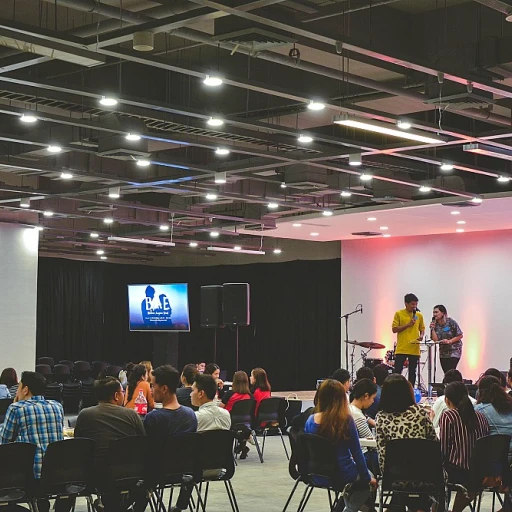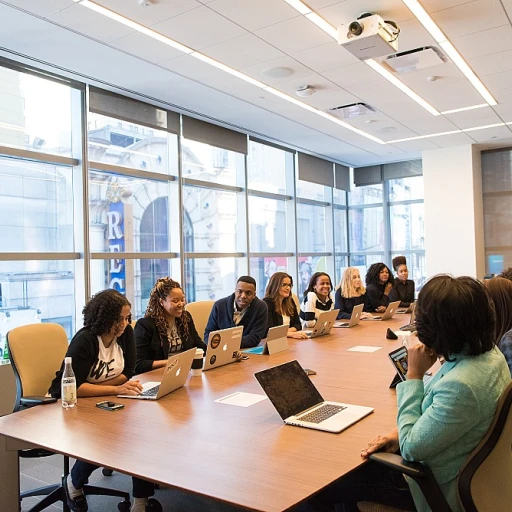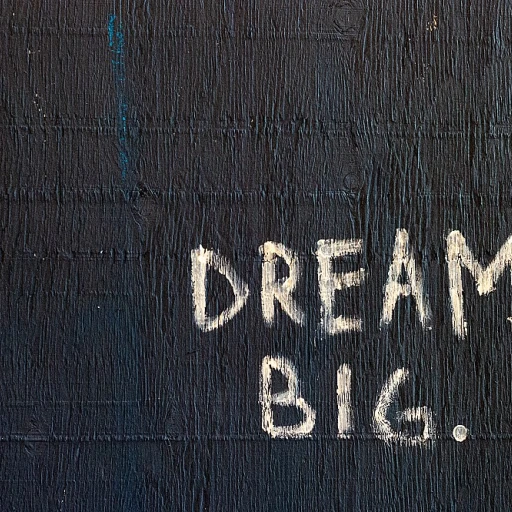
Understanding the msg Workforce
Grasping the Dynamics of the Workforce
Understanding the modern workforce is pivotal for developing effective communication strategies in Human Resources. The msg workforce, like that in a bustling city such as York, embodies a diversity that ranges from full-time employees to those engaged in global partnerships and workforce development initiatives. Each department, from technical assistance to platforms engineering, plays a critical part in shaping how communication unfolds. The workforce is no longer confined to square office spaces or time-bound shifts. Madison Square Garden, a key player in entertainment, epitomizes the shift towards flexible job roles and dynamic workforce systems. This evolution necessitates a paradigm shift in how HR manages communication, with a particular emphasis on integrating workforce software and measurable skill gains. Across organizations, the HR department must contend with an increasing reliance on data and York City-like pace that demands quick adaptation. Senior analysts and managers of people, as well as directors in global roles, must navigate these changeable environments ensuring that communication channels are always in sync with employee shifts. When you consider the garden-variety issues that can arise, among them time management and attendance tracking, it's clear that HR communication requires precise coordination and clarity. As we move forward, applying effective strategies will entail carefully balancing employee needs with organizational goals, a subject further explored in resources like building stronger connections in remote work.Key Challenges in Human Resources Communication
Addressing Complex Communication Challenges
Human resources departments face a myriad of challenges when communicating effectively with the workforce, particularly in a vibrant and bustling city like New York. The diversity of industries, such as garden entertainment and full-time job markets, coupled with multiple time zones, makes meaningful connections within the madison square garden environment uniquely challenging. The need for reliable and timely communication is heightened, given the constant mobility and fast-paced nature of a york city workforce.Overcoming Cultural and Linguistic Barriers
The cultural diversity present in a global city often leads to language and cultural misunderstandings within teams. Whether it’s the technical assistance team or the senior analyst group, each department requires specific strategies that cater to their unique communication needs. Understanding cultural nuances and fostering an inclusive communication culture allows employees to thrive and contribute effectively.Navigating Organizational Changes
Frequent changes within big companies often result in miscommunication. A shift in job roles or department restructuring can pose serious communication challenges. The application of workforce development strategies is crucial here. Ensuring that each employee, from the director global to the senior accountant, understands their role and the overall mission is imperative for maintaining morale and productivity.Data Overload and Information Filtering
Information overload is another challenge that HR professionals often encounter. The vast amounts of data generated by workforce systems can overwhelm not only the HR team but the employees too. Methods for skill gains can be lost if information is not filtered and communicated effectively. It’s essential to apply measurable skill outcomes and platform engineer insights to manage data efficiently.Balancing Traditional and Modern Platforms
The advent of workforce software and time attendance tools presents both an opportunity and a challenge. Balancing traditional communication methods with new platforms is crucial to meet the diverse preferences across different age groups within the workforce. Embracing technology without losing the human touch ensures messages are conveyed effectively to both newer graduates and senior members of the team. Navigating these challenges requires not only strategic foresight but also an ongoing commitment to refining communication processes. To learn more about the pivotal role of workforce integration managers in addressing these challenges, read more about the role of workforce integration managers in human resources communication.Strategies for Effective Communication
Crafting Clear and Concise Messages
Effective communication in the msg workforce starts with clarity. Whether you are addressing a department or the entire workforce, messages should be clear and concise. Avoid jargon and tailor your communication to the audience's understanding level. This approach is crucial in environments like York City where diverse teams require straightforward communication to ensure everyone is on the same page.
Utilizing Multiple Channels
In today's dynamic work environments, relying on a single communication channel is insufficient. Integrate various platforms like emails, intranets, and social media to reach different segments of your workforce. For instance, the Madison Square Garden entertainment sector may benefit from real-time updates through mobile apps, while senior analysts might prefer detailed reports via email. Tailoring your channel to the audience can significantly enhance engagement and message retention.
Promoting Feedback and Interaction
Encourage a culture of open dialogue by promoting feedback and interaction. This can be achieved by organizing regular town halls or team meetings where employees can voice their concerns and suggestions. Additionally, platforms that support workforce development and global partnerships can facilitate cross-departmental communication, fostering a more inclusive environment. Feedback mechanisms are not just about listening but also about implementing feasible suggestions to show that employee input is valued.
Training and Development
Investing in communication training for managers and team leaders is essential. This ensures they have the skills to convey messages effectively and manage diverse teams. Workshops on measurable skill gains and workforce systems can enhance communication capabilities, making it easier for leaders to adapt to changes and new technologies. This aligns with the Trusted Workforce 2.0 initiative, which emphasizes the importance of adapting communication strategies to modern needs.
The Role of Technology in HR Communication
Leveraging Technology for Enhanced HR Communication
Modern HR departments are increasingly turning to technology to navigate the complexities of msg workforce communication. The capabilities offered by these advanced tools allow HR teams to address challenges more efficiently and engage with their workforce more effectively. Firstly, workforce software plays a critical role in information dissemination and data management. As the workplace becomes more diverse and geographically dispersed, integrating comprehensive systems for tracking time and attendance can streamline processes and foster better communication across various locations like York City, Madison Square, and beyond. Collaboration platforms are essential in today's msg workforce environment. These tools allow employees and managers to connect, share ideas quickly, and resolve issues promptly. Platforms such as those utilized by global partnerships and full-time job teams offer real-time updates and feedback loops. Moreover, technology facilitates measurable skill gains through online training modules, helping employees to advance their careers without the need for traditional in-person training. This adaptability is particularly valuable in sectors like garden entertainment and the fast-paced world of senior analysts. Lastly, with the rise of telecommuting and remote work setups in departments such as the square garden entertainment team, implementing robust communication systems is crucial. These systems help in maintaining transparency and open channels among employees and directors, ensuring that everyone is aligned with company goals and objectives. In conclusion, the role of technology in HR communication is multi-faceted. It not only aids in overcoming key challenges but also helps in building a more connected and engaged workforce. As organizations continue to evolve, utilizing technical assistance and leveraging workforce development tools will be paramount in facilitating effective communication across all levels of employment, from senior accountants to manager people teams.Building a Culture of Open Communication
Fostering an Atmosphere of Openness
In the fast-paced and diverse environment of a company in a vibrant city like York City, nurturing a culture of open communication is crucial. This becomes especially significant when dealing with the multi-faceted msg workforce. Encouraging employees, from the energetic team members of the Madison Square Garden entertainment hub to the analytical minds of the senior analysts in workforce systems, to express their ideas freely ensures a more inclusive and innovative workplace.
Open communication contributes to greater employee satisfaction and improved performance. Employees who feel heard by their managers and their department are more likely to feel valued and engaged. This is particularly relevant in large organizations where departments may feel siloed. A job that prioritizes open dialogue allows employees at every level, from platform engineers to director global roles, to contribute their unique perspectives.
Communication Channels and Policies
To achieve a culture where communication flows freely, it is essential to establish clear communication channels and policies. These should be as adaptable as the garden of services offered by a city's workforce, catering to full-time and part-time employees across various departments. Regular feedback loops and open-door policies can make communication more accessible. Teams can adopt platforms like workforce software to streamline time attendance and enhance data sharing, creating a seamless exchange of information.
Empowering Employees with Communication Tools
The application of practical communication tools empowers all employees, from the senior accountant managing financial intricacies to an analyst immersing in workforce development projects. These tools can facilitate a visible change in how messages are conveyed and received within the company. Technical assistance in utilizing these communication solutions helps in bridging gaps and mitigating misunderstandings, lending to more effective interpersonal interactions.
Ultimately, fostering a culture of open communication is not a one-time job but a continuous journey. By reinforcing these strategies over time, organizations can cultivate a truly open environment that aligns with the needs and aspirations of the workforce.
Measuring Communication Effectiveness
Evaluating Communication Success in HR
Measuring the effectiveness of communication strategies within the HR department is crucial for ensuring the msg workforce remains engaged and informed. In a dynamic environment like York City, where time job opportunities and workforce systems are constantly evolving, it becomes essential to apply measurable skill assessments to gauge the impact of communication efforts.
Key Performance Indicators (KPIs)
To effectively measure communication effectiveness, HR departments can utilize a variety of KPIs. These may include employee engagement scores, feedback from workforce development initiatives, and the effectiveness of workforce software in facilitating communication. By tracking these metrics, HR teams can identify areas for improvement and celebrate successes.
Feedback Mechanisms
Implementing regular feedback mechanisms is another effective strategy. This can include surveys and focus groups that allow employees to express their thoughts on communication strategies. For instance, a senior analyst might provide insights into how communication impacts their role within the team, while a platform engineer could highlight technical assistance needs. Gathering this data helps in making informed decisions.
Technology's Role in Measurement
Technology plays a significant role in measuring communication effectiveness. Workforce software and time attendance systems can provide valuable data on how well communication channels are being utilized. By leveraging these tools, HR departments can ensure that messages are reaching the intended audience, be it employees at Madison Square Garden or those in global partnerships.
Continuous Improvement
Finally, fostering a culture of continuous improvement is essential. By regularly reviewing communication strategies and their outcomes, HR departments can adapt to changes in the workforce and industry. This proactive approach ensures that communication remains effective, whether addressing the needs of a senior accountant or a director of global services.












